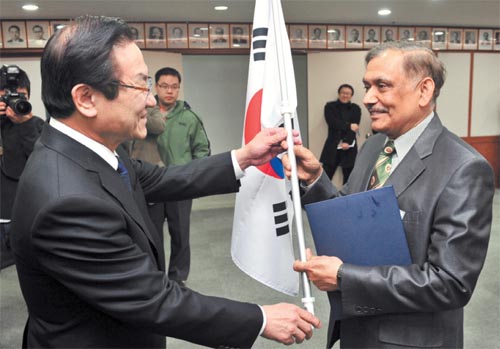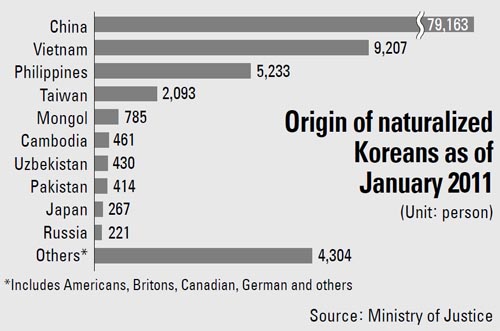Move to embrace open immigration

Minister of Justice Lee Kwi-nam, left, awards citizenship on Jan. 24 to Indian Professor Roy Alok Kumar, 55, the 100,000th foreigner to receive Korean citizenship after having lived here for 31 years. [NEWSIS]
When a young Indian man named Roy Alok Kumar arrived in Korea 31 years ago to study on a Korean scholarship, he only intended to stay for a few years and planned to go back to India after completing his studies.
Until he fell in love with Korea, that is.
“Life is a journey and one passes through many gates,” Kumar said in an interview with Korea JoongAng Daily. “It took me 30 years to approach this puzzle of who I am. During all those years my thinking matured and so did the attitude of Korean society toward people like me. I thought that it should be my address, too.”
Kumar, a professor of Indian language at Pusan University of Foreign Studies, became the 100,000th naturalized citizen after new rules allowing dual citizenship in Korea took effect in January.
Kumar, 55, saluted the Korean flag during his citizenship ceremony in Seoul on Jan. 24.
“I’ve paid my taxes for 30 years, but still, when it comes down to it, I’m a foreigner,” Kumar said. “It’s like I’d come into the Korean yard, but I hadn’t been given the key to the house. In order to have a better life, I thought I should become a citizen.”
The Ministry of Justice announced in January that the number of foreigners naturalized as Korean citizens surpassed the 100,000 mark, 63 years after the Korean government was formed in 1948.
A Taiwanese man was the first foreigner to receive Korean citizenship 44 years ago.
The world’s 15th largest economy by gross domestic product, according to the International Monetary Fund, is struggling to overcome a low birthrate and a rapidly graying population.
Korea’s birthrate is among the lowest in the world at 1.24, far below the global average of 2.52.
Statistics Korea has forecasted that 40 percent of the Korean population will over 65 in 2050.

Kumar, who is married to a Korean and has two daughters, was able to gain Korean citizenship after 31 years, while still maintaining his Indian nationality.
Starting this year, the Korean government is allowing highly skilled workers to retain dual citizenship.
Kumar said the new regulation made it easier for him to obtain Korean citizenship.
Before the open immigration policy was launched this year, only foreigners who lived between three and five consecutive years in Korea were eligible to apply for naturalization.
Under Korean law, a person who has a domicile address in Korea for more than five consecutive years is eligible to apply for naturalization.

If a person who maintained a marriage and kept a residence in Korea for more than two consecutive years or maintained marital status for three consecutive years and spent more than one year in Korea, he or she is eligible for simplified naturalization.
Korea previously banned dual citizenship, and when turning 19, a person with different nationalities had to decide whether he or she wanted to be Korean or another nationality. The measure was designed by the Roh Moo-hyun administration to put an end to draft-dodging scandals.
But the Lee administration chose a different path, believing that open immigration policies would help Korea rejuvenate its aging society.
“As of the end of December 2010, the number of foreigners in Korea surpassed 1.25 million people, marking 2.5 percent of the population,” Prime Minister Kim Hwang-sik said during a January Foreign Policy Committee meeting, which coordinates the various ministries’ foreigner-related policies.
“If we don’t push immigration policies without thorough preparation, our next generation will shoulder the burden. The government must come up with systematic measures to support foreigners because they are expected to increase in line with Korea’s economic development.”
According to the Justice Ministry, the average annual number of newly naturalized citizens stood at 34 until 2000, but the average annual figure skyrocketed to 9,816 between 2001 and 2010, a time period that accounts for 98 percent of all naturalized citizens.
Among naturalized citizens since 1948, Chinese make up the largest group with 79,163, or 79 percent of the total, followed by Vietnamese with 9,207. There were 5,233 Filipinos and 2,093 Taiwanese. Very few from the West have been naturalized.
The Justice Ministry said the increase is largely due to the growing influx of marriage immigrants from Southeast Asian nations and immigration laws that allow Chinese nationals of Korean background to acquire Korean citizenship.
Seo Min-soo, a 39-year-old former Nepalese migrant-worker-turned-businessman who runs a restaurant in Seoul, said there are benefits to obtaining Korean citizenship.
“Things changed a lot after I obtained my Korean nationality, I mean in a good way,” Seo said.
“When I present my Korean identification card at banks to consult on business loans and on other occasions when I need advice, I get different treatment,” Seo added.
Seo had many ups and downs in the past, until he become a Korean national, and he said he still remembers the hardships.
Seo, who formerly used his Nepalese name Binod Kunwor, came to Korea as a migrant worker in 1992.
He worked hard at a dyehouse in Uijeongbu, Gyeonggi, but received a meager salary of 320,000 won ($285) per month. Seo originally intended to go back to Nepal after completing his one-year as a legal worker, but he chose to stay illegally because he wanted to earn money for one more extra year.
So, Seo worked at several dyehouses in Uijeongbu. During the 1997 Asian financial crisis, he worked as a manual laborer at construction sites and he met a Korean woman.
Seo, however, was deported to Nepal in 1999 after he was caught working illegally. Seo and Lee were married in Nepal in 2000 and then re-entered Korea.
Seo carved out a living as a textile-mill worker during the day and devoted his nights exporting Korean clothes sold in Dongdaemun Market to Nepal.
After noticing very little South Asian cuisine in Korea, Seo opened a Indian and Nepalese restaurant in Jongno, central Seoul, in 2006.
He’s now a successful businessman who runs four restaurants in Seoul.
Seo said more work needs to be done to make expats “truly feel at home.”
“We encounter the other side of difficulties after obtaining Korean nationality,” Seo said. “I’m officially Korean but when I talk to people they still see and treat me as a foreigner because of my accent and different skin color.”
Seo said improving the educational environment for children born into multiethnic families should be the government’s priority.
“Children born into multiethnic families like ours only learn Korean culture and they don’t learn the culture of their father’s or mother’s country when they’re enrolled in elementary school,” Seo said.
“Children need to be exposed to different cultures starting from when they are in day-care centers and preschools so they can embrace two different backgrounds. I and many others agonize over our children’s education,” he said.
Seo said the government must build schools where children with multiethnic parents and their peers born from Korean parents can learn together about other countries.
Seo is opposed to the idea of building schools for multiethnic children because they could be isolated from Korean society.
“We don’t have information on which schools offer multiethnic education,” Seo said.
Critics say the government should establish an immigration administration if it wants to make open immigration policy successful.
“To embrace multiethnic arrangements in conservative Korean society and to keep strife between different cultures to a minimum, we need an immigration administration as a control tower, charting immigration policies,” said Chung Ki-seon, a senior researcher at the Seoul office of the International Organization for Migration.
Chung, who’s also an adviser for the Prime Minister’s Office’s Foreign Policy Committee, said that while the Ministry of Gender Equality and Family supports multiethnic families, the Ministry of Education, Science and Technology is in charge of multiethnic education in schools.
“But when their mothers become fully adapted to living in Korea, they find jobs and the Ministry of Labor assists their needs,” Chung said. “Ministries run bureaus dealing with foreigners and multiethnic families but they should be integrated into the administration.”
Chung said the committee’s task is limited because the Foreign Policy Committee holds a meeting twice a year and invites cabinet ministers and outside experts.
“The committee is not a decision-making body,” Chung said. “In 2050, the Korean population will experience enormous changes due to a low birthrate and aging society.
“We shouldn’t only talk about bringing marriage immigrants here but also discuss and do research about how and who we should welcome. We need to calculate the social costs of new neighbors, too,” Chung added.
Kumar said the Korean government needs to think about Korea some 20 and 30 years from now.
“Having a foreign bride or groom in the family may not be somebody else’s reality,” Kumar said.
“This is how developed societies all over the world, including America and Europe, have handled this challenge. Korea should learn from their experiences. Let every city in Korea be a Silicon Valley.”
By Kim Mi-ju [mijukim@joongang.co.kr]
Related Korean Article[연합]
10만번째 귀화인 로이 알록 꾸마르 교수
"외국인을 국민으로 품을 정도로 한국의 마음 넓어져"
대한민국 정부 수립 이후 63년 만에 '10만번째 귀화인'으로 등록된 인도 출신 로이 알록 꾸마르(55) 부산외국어대 교수는 24일 법무부에서 열린 '귀화자 10만명 기념행사' 내내 흐뭇한 미소를 잃지 않았다.
1980년 정부초청 장학생으로 처음 입국한 이후 31년 만에 귀화증서를 받고 한국민으로 '인생 2막'을 여는 순간을 마음속으로 자축하는 듯한 표정이었다. 멀리 부산에서 함께 온 한국인 부인도 자랑스러운 눈길로 그를 바라봤다.
인도의 명문 델리대에서 정치학을 전공한 그는 졸업 직후 동북아 정치를 연구하고자 한국을 찾게 됐다고 한다. 주변에서 대개 아시아의 문화중심지 중국과 경제대국 일본으로 유학을 떠날 당시 동방의 작은 나라 한국은 그에게 오히려 '블루오션'의 땅이었다.
서울대 유학생 신분으로 한국과 인도를 오가다 지금의 부인을 만나게 됐고 두명의 딸을 낳아 가정을 꾸리면서 한국은 그에게 '제2의 조국'으로 다가왔다. 그러나 한국 국적 취득은 또 다른 문제였다.
그는 연합뉴스와의 인터뷰에서 "국적 취득은 단순히 주소를 바꾸는 문제가 아니다"며 "한국이라는 나라의 담을 넘어 마당까지 왔지만 안방의 열쇠(국적)를 차지하기 위해서는 마음의 준비가 필요했다"고 털어놨다.
그가 그동안 국적 취득을 망설인 것은 '순혈주의'로 대변되는 외국인에 대한 배타적 사회분위기 때문이었다. 30년 넘게 한국땅에서 살아왔고 한국인 부인 사이에 자식까지 가졌지만 그는 여전히 가난한 제3세계 출신의 이방인일 수밖에 없었던 것.
아이들이 "우리는 100% 한국인이기도 하고 100% 인도인이기도 한데 왜 사람들은 우리를 절만만 한국인이라고 하냐"며 불만을 토로할 때는 비애를 느끼기도 했다고 한다.
그러나 세월이 흘러 국제화가 빠르게 진행된 한국 사회가 이제는 외국인도 차별 없이 받아들일 정도로 성숙했다는 것을 자각하면서 국적을 취득하기로 마음을 바꿨다.
그는 "한국이라는 나라가 외국인을 국민의 한 사람으로 품을 정도로 마음이 넓어졌고, 나 역시 이제 한국을 조국으로 받아들일 준비가 됐다"며 "한국과 나의 관계가 성숙하고 발전했다는 것이 국적취득을 신청한 가장 큰 이유"라고 설명했다.
작년 2월에 국적취득을 신청한 그는 지난 1일부터 이중국적 혜택의 폭을 넓힌 개정 국적법이 시행됨에 따라 인도 국적을 유지하면서 한국 국적도 얻는 행운까지 누리게 됐다.
그는 "인도에서도 이탈리아 출신인 소니아 간디가 인도로 국적을 바꾸고 나서 대중에게 사랑받는 정치인이 되지 않았느냐"며 "대한민국 국민으로서 한국 사회를 위해 좋은 일을 하고 싶다"고 포부를 밝혔다.










with the Korea JoongAng Daily
To write comments, please log in to one of the accounts.
Standards Board Policy (0/250자)